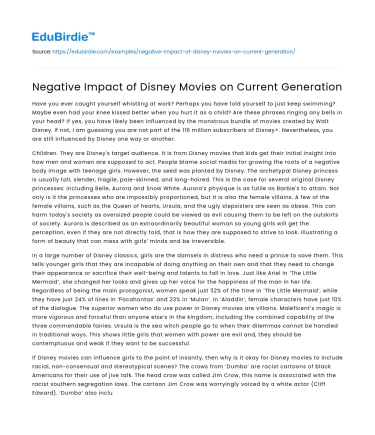Have you ever caught yourself whistling at work? Perhaps you have told yourself to just keep swimming? Maybe even had your knee kissed better when you hurt it as a child? Are these phrases ringing any bells in your head? If yes, you have likely been influenced by the monstrous bundle of movies created by Walt Disney. If not, I am guessing you are not part of the 116 million subscribers of Disney+. Nevertheless, you are still influenced by Disney one way or another.
Children. They are Disney's target audience. It is from Disney movies that kids get their initial insight into how men and women are supposed to act. People blame social media for growing the roots of a negative body image with teenage girls. However, the seed was planted by Disney. The archetypal Disney princess is usually tall, slender, fragile, pale-skinned, and long-haired. This is the case for several original Disney princesses: including Belle, Aurora and Snow White. Aurora's physique is as futile as Barbie's to attain. Not only is it the princesses who are impossibly proportioned, but it is also the female villains. A few of the female villains, such as the Queen of hearts, Ursula, and the ugly stepsisters are seen as obese. This can harm today's society as oversized people could be viewed as evil causing them to be left on the outskirts of society. Aurora is described as an extraordinarily beautiful woman so young girls will get the perception, even if they are not directly told, that is how they are supposed to strive to look. Illustrating a form of beauty that can mess with girls’ minds and be irreversible.
Save your time!
We can take care of your essay
- Proper editing and formatting
- Free revision, title page, and bibliography
- Flexible prices and money-back guarantee
In a large number of Disney classics, girls are the damsels in distress who need a prince to save them. This tells younger girls that they are incapable of doing anything on their own and that they need to change their appearance or sacrifice their well-being and talents to fall in love. Just like Ariel in ‘The Little Mermaid’, she changed her looks and gives up her voice for the happiness of the man in her life. Regardless of being the main protagonist, women speak just 32% of the time in ‘The Little Mermaid’, while they have just 24% of lines in ‘Pocahontas’ and 23% in ‘Mulan’. In ‘Aladdin’, female characters have just 10% of the dialogue. The superior women who do use power in Disney movies are villains. Maleficent’s magic is more vigorous and forceful than anyone else’s in the kingdom, including the combined capability of the three commendable fairies. Ursula is the sea witch people go to when their dilemmas cannot be handled in traditional ways. This shows little girls that women with power are evil and, they should be contemptuous and weak if they want to be successful.
If Disney movies can influence girls to the point of insanity, then why is it okay for Disney movies to include racial, non-consensual and stereotypical scenes? The crows from ‘Dumbo’ are racist cartoons of black Americans for their use of jive talk. The head crow was called Jim Crow, this name is associated with the racist southern segregation laws. The cartoon Jim Crow was worryingly voiced by a white actor (Cliff Edward). ‘Dumbo’ also includes a song called ‘Song of the Roustabouts’, which consists of faceless black circus workers singing insulting lyrics such as ‘we slave until we are almost dead, were happy-hearted roustabouts’ and ‘keep on working, stop that shirking, pull that rope, you hairy ape’. Many people may argue that Disney movies have had a positive impact on their life, by teaching them valuable lessons like a sense of hope, just keep swimming, set your goals high, hard work is key to success the list goes on and on. However, it's difficult for these ambitions to occur if people are treated the way the circus workers are treated. Not only are these lessons difficult to implement, but they are also unrealistic and can lead to terrible events. It does not stop there, in ‘Snow White and the Seven Dwarfs’ the prince kisses Snow White whilst she was passed out and thought to be dead. Therefore, this is an act of assault and seen as non-consensual. Actress Kirsten Bell asks her daughters in an interview with parents.com: “Don't you think that it's weird that the prince kisses Snow White without her permission? Because you cannot kiss someone if they're sleeping!”. Besides Princess Anna's voice-over, stating her views on the scene, many parents have made it evident that they don't feel comfortable showing this scene with their kids. In ‘Peter Pan’, Peter and his darling siblings go to visit his friend Tiger Lily, who belongs to the Native American tribe. The way the movie portrays Native American culture is stereotypical. The characters speak in gibberish instead of an actual indigenous language, smoke excessive amounts of pipe tobacco (which they offer to the children) and sing an offensive song called ‘What Made the Red Man Red’. Grouping all American Indians as one monolithic caricature is grossly offensive because these are real people with many different cultures.
Disney has dominated the animated film industry, for over 9 and a half decades and can easily influence and persuade people, so why would Disney think it is okay to use their power in a way that can destroy people’s lives?






 Stuck on your essay?
Stuck on your essay?

